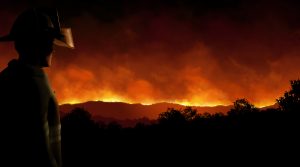
Every year our architecture firm in Lake Tahoe strives to share information about the (unfortunate) fire season in the High Sierra. To get you ahead of the curve, we have obtained some excellent information from the University of Nevada, Reno, that provides tips on what you can do around your home to help protect it from fires.
The tips include specific information on how to retrofit existing parts of your home to withstand fires if they happen to enter your neighborhood.
As you read on, remember this fact: In wildfire events, 60 – 90%of home loss is due to embers.
We encourage you to take the time to read our forthcoming News articles and share them with your neighbors as well.
The more you do to protect your home and its environment, the better the chances are of your home surviving a forest fire.
House Location
How and where your house is located makes a big difference as to how vulnerable your home may be.
Steep Slope or Forest Setting? When homes are located on steep slopes it is very common to have a few porches hanging over natural vegetation. Experts suggest you remove as many of the bushes as possible between your porch and back or front yard. The more space the better.
Forrest Setting? Same concept as above. We love our home in the mountains wrapped in the forest. Yet as much as it is a beautiful setting, it’s probably the most vulnerable spot one can live. Do your best to remove all low-hanging limbs and deciduous ‘duff’ in and around the tree wells.
Large Lot? When one has a good-sized lot or plenty of acreage, it is not uncommon to have a garden shed, large wood pile, and other structures that are susceptible to fire. Trim around these features and be sure that the wood pile is a good distance from the house.
Your Roof
There are three types of roofing.
Class A – Preferred: Made of asphalt fiberglass composition, shingles, clay and cementitious tiled, metal
Class B – Pressure impregnated fire-retardant treaded share or shingle
Class C – Recycled plastic, rubber, and aluminum
There are key things you can do to lower your home’s vulnerability to fire.
- Replace it with Class A (unless that is on your home now)
- Remove all debris – especially after the windy fall season (i.e. pine needles need to go!)
- Clear your gutters
- Install non-combustible and corrosion-resistant metal drip edging
- Inspect open-eves areas for gaps where embers could land
And that is just the beginning. Keep watching our News section for additional tips to keep your home as fire-safe as possible during the summer, and year-round. The Sierra has been known to have an unexpected fire season in the winter months as well.
We want to take this time to thank the University of Nevada, Reno Extension, College of Agriculture for proving this information to you. For more insight about how to prepare and keep your home safe from fire, visit www.unr.edu/avrs.

James P. Borelli
Founder/Principal
Borelli Architecture
Lake Tahoe / Truckee
jim@borelliarchitecture.com
775.831.3060
